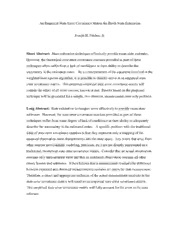
NASA Technical Reports Server (NTRS) 20110010280: An Empirical State Error Covariance Matrix for Batch State Estimation PDF
Preview NASA Technical Reports Server (NTRS) 20110010280: An Empirical State Error Covariance Matrix for Batch State Estimation
An Empirical State Error Covariance Matrix for Batch State Estimation Joseph H. Frisbee, Jr. Short Abstract: State estimation techniques effectively provide mean state estimates. However, the theoretical state error covariance matrices provided as part of these techniques often suffer from a lack of confidence in their ability to describe the uncertainty in the estimated states. By a reinterpretation of the equations involved in the weighted least squares algorithm, it is possible to directly arrive at an empirical state error covariance matrix. This proposed empirical state error covariance matrix will contain the effect of all error sources, known or not. Results based on the proposed technique will be presented for a simple, two observer, measurement error only problem. Long Abstract: State estimation techniques serve effectively to provide mean state estimates. However, the state error covariance matrices provided as part of these techniques suffer from some degree of lack of confidence in their ability to adequately describe the uncertainty in the estimated states. A specific problem with the traditional form of state error covariance matrices is that they represent only a mapping of the assumed observation error characteristics into the state space. Any errors that arise from other sources (environment modeling, precision, etc.) are not directly represented in a traditional, thoeretical state error covariance matrix. Consider that an actual observation contains only measurement error and that an estimated observation contains all other errors, known and unknown. It then follows that a measurement residual (the difference between expected and observed measurements) contains all errors for that measurement. Therefore, a direct and appropriate inclusion of the actual measurement residuals in the state error covariance matrix will result in an empirical state error covariance matrix. This empirical state error covariance matrix will fully account for the error in the state estimate. By way of a literal reinterpretation of the equations involved in the weighted least squares estimation algorithm, it is possible to arrive at an appropriate, and formally correct, empirical state error covariance matrix. The first specific step of the method is to use the average form of the weighted measurement residual variance performance index rather than its usual total weighted residual form. Next it is helpful to interpret the solution to the normal equations as the average of a collection of sample vectors drawn from a hypothetical parent population. From here, using a standard statistical analysis approach, it directly follows as to how to determine the standard empirical state error covariance matrix. This matrix will contain the total uncertainty in the state estimate, regardless as to the source of the uncertainty. Also, in its most straight forward form, the technique only requires supplemental calculations to be added to existing batch algorithms. The generation of this direct, empirical form of the state error covariance matrix is independent of the dimensionality of the observations. Mixed degrees of freedom for an observation set are allowed. As is the case with any simple, empirical sample variance problems, the presented approach offers an opportunity (at least in the case of weighted least squares) to investigate confidence interval estimates for the error covariance matrix elements. The diagonal or variance terms of the error covariance matrix have a particularly simple form to associate with either a multiple degree of freedom chi-square distribution (more approximate) or with a gamma distribution (less approximate). The off diagonal or covariance terms of the matrix are less clear in their statistical behavior. However, the off diagonal covariance matrix elements still lend themselves to standard confidence interval error analysis. The distributional forms associated with the off diagonal terms are more varied and, perhaps, more approximate than those associated with the diagonal terms. Using a simple weighted least squares sample problem, results obtained through use of the proposed technique are presented. The example consists of a simple, two observer, triangulation problem with range only measurements. Variations of this problem reflect an ideal case (perfect knowledge of the range errors) and a mismodeled case (incorrect knowledge of the range errors). Copyright © 2011 by United Space Alliance, LLC. These materials are sponsored by the National Aeronautics and Space Administration under Contract NNJ09HA15C. The U.S. Government retains a paid-up, nonexclusive, irrevocable worldwide license in such materials to reproduce, prepare, derivative works, distribute copies to the public, and perform publicly and display publicly, by or on behalf of the U.S. Government. All other rights are reserved by the copyright owner.
